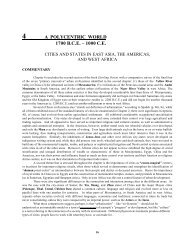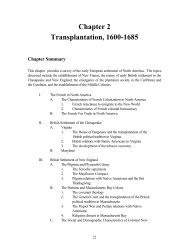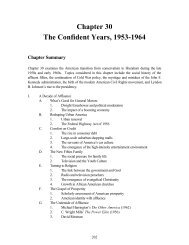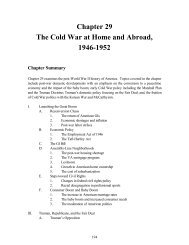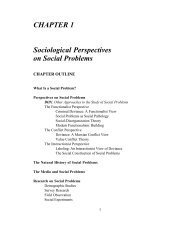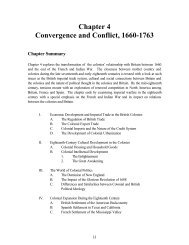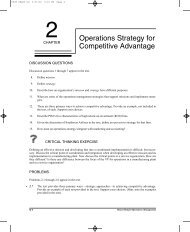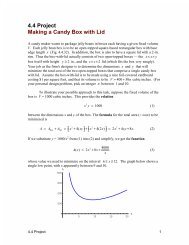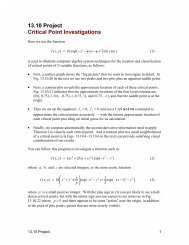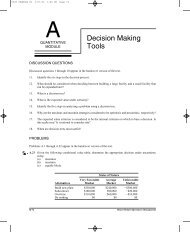Merchandising Operations and the Accounting Cycle - Pearson
Merchandising Operations and the Accounting Cycle - Pearson
Merchandising Operations and the Accounting Cycle - Pearson
You also want an ePaper? Increase the reach of your titles
YUMPU automatically turns print PDFs into web optimized ePapers that Google loves.
EXHIBIT 5-5<br />
Trial Balance<br />
238 Part One The Basic Structure of <strong>Accounting</strong><br />
AUSTIN SOUND CENTRE INC.<br />
Trial Balance<br />
December 31, 2004<br />
Cash ...................................................................................... $ 2,850<br />
Accounts receivable ........................................................... 4,600<br />
Note receivable, current .................................................... 8,000<br />
Interest receivable ...............................................................<br />
Inventory ............................................................................. 40,500<br />
Supplies ............................................................................... 650<br />
Prepaid insurance .............................................................. 1,200<br />
Furniture .............................................................................. 33,200<br />
Accumulated amortization—furniture ........................... $ 2,400<br />
Accounts payable ............................................................... 47,000<br />
Unearned sales revenue .................................................... 2,000<br />
Wages payable .....................................................................<br />
Interest payable ...................................................................<br />
Note payable, long-term ................................................... 12,600<br />
Common stock..................................................................... 10,000<br />
Retained earnings................................................................ 15,900<br />
Dividends............................................................................. 54,100<br />
Sales revenue ..................................................................... 168,000<br />
Sales discounts .................................................................. 1,400<br />
Sales returns <strong>and</strong> allowances .......................................... 2,000<br />
Interest revenue .................................................................. 600<br />
Cost of goods sold ............................................................. 90,500<br />
Amortization expense—furniture ...................................<br />
Insurance expense...............................................................<br />
Interest expense .................................................................. 1,300<br />
Rent expense ....................................................................... 8,400<br />
Supplies expense .................................................................<br />
Wages expense .................................................................... 9,800<br />
Total ...................................................................................... $258,500 $258,500<br />
Additional data at December 31, 2004:<br />
a. Interest revenue earned but not yet collected, $400.<br />
b. Inventory on h<strong>and</strong>, $40,200.<br />
c. Supplies on h<strong>and</strong>, $100.<br />
d. Prepaid insurance expired during <strong>the</strong> year, $1,000.<br />
e. Amortization, $600.<br />
f. Unearned sales revenue earned during <strong>the</strong> year, $1,300.<br />
g. Accrued wage expense, $400.<br />
h. Accrued interest expense, $200.<br />
Dec. 31 Cost of Goods Sold..................................................... 300<br />
Inventory................................................................ 300<br />
This entry brings Inventory <strong>and</strong> Cost of Goods Sold to <strong>the</strong>ir correct balances.<br />
Austin Sound’s December 31, 2004, adjustment data, including this inventory information<br />
[item (b)], are given at <strong>the</strong> bottom of Exhibit 5-5.<br />
The physical count can indicate that more inventory is present than <strong>the</strong> books<br />
show. A search of <strong>the</strong> records may reveal that Austin Sound received inventory but<br />
did not record <strong>the</strong> corresponding purchase entry. This would be entered <strong>the</strong> st<strong>and</strong>ard<br />
way: debit Inventory <strong>and</strong> credit Cash or Accounts Payable. If <strong>the</strong> reason for <strong>the</strong> excess<br />
inventory could not be identified, <strong>the</strong> business adjusts <strong>the</strong> accounts by debiting<br />
Inventory <strong>and</strong> crediting Cost of Goods Sold. To illustrate a merch<strong>and</strong>iser’s adjusting<br />
<strong>and</strong> closing process, let’s use Austin Sound’s December 31, 2004, trial balance in



